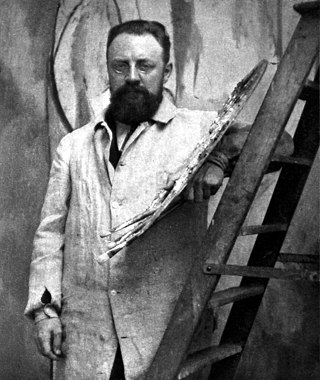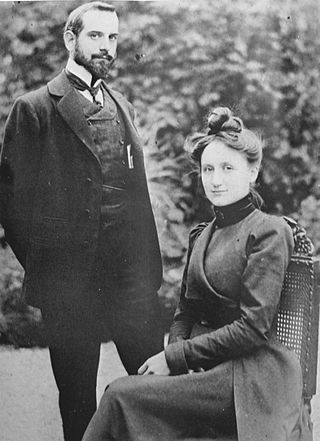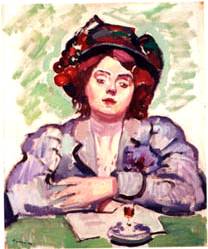
Henri Émile Benoît Matisse was a French visual artist, known for both his use of colour and his fluid and original draughtsmanship. He was a draughtsman, printmaker, and sculptor, but is known primarily as a painter. Matisse is commonly regarded, along with Pablo Picasso, as one of the artists who best helped to define the revolutionary developments in the visual arts throughout the opening decades of the twentieth century, responsible for significant developments in painting and sculpture.
John Elderfield was Chief Curator of Painting and Sculpture at the Museum of Modern Art, New York, from 2003 to 2008. He served as the Allen R. Adler, Class of 1967, Distinguished Curator at the Princeton University Art Museum and Lecturer in the Princeton University Department of Art and Archaeology from 2012 to 2019.
The Kunstareal is a museum quarter in the city centre of Munich, Germany.

The Green Stripe is an oil painting from 1905 by French artist Henri Matisse of his wife, Amélie Noellie Matisse-Parayre. The title stems from the vertical green stripe down the middle of Madame Matisse's face, an artistic decision consistent with the techniques and values of Fauvism. The painting features a bust-length view of Madame Matisse in blocks of bold and vibrant colors. It is associated with the Fauvist Movement due to this unnatural and experimental use of color. The portrait has received both praise and criticism due to this technique as well as the artistic representation of the model. The Green Stripe is currently displayed in the Staten Museum for Kunst in Copenhagen, Denmark.

The National Gallery of Denmark is the Danish national gallery, located in the centre of Copenhagen.

Henri Charles Manguin was a French painter, associated with the Fauves.

Charles Camoin was a French expressionist landscape painter associated with the Fauves.

The Young Sailor II is a painting by Henri Matisse from 1906. It is in the collection of the Metropolitan Museum of Art, in New York.

Woman with a Hat is an oil-on-canvas painting by Henri Matisse. It depicts Matisse's wife, Amélie Matisse. It was painted in 1905 and exhibited at the Salon d'Automne during the autumn of the same year, along with works by André Derain, Maurice de Vlaminck and several other artists later known as "Fauves".

Zorah on the Terrace is an oil on canvas painting by French painter Henri Matisse, created in 1912. It is in the collection of the Pushkin Museum of Fine Arts, Moscow, Russia.

Woman Reading is an oil-on-board painting executed in 1895 by the French artist Henri Matisse. It is displayed at the Musée Matisse, in Le Cateau-Cambrésis, having been on loan from the Centre Pompidou since 2002. It shows a woman, dressed in black, seated and reading, with her back to the viewer, in the calmness of a somewhat cluttered room. Matisse incorporated a self-portrait into the painting in the form of a framed drawing hanging on the wall at the upper left.

Woman on a High Stool is an oil painting on canvas by the French artist Henri Matisse from early 1914. It is held in the Museum of Modern Art, in New York.

Fauvism is a style of painting and an art movement that emerged in France at the beginning of the 20th century. It was the style of les Fauves, a group of modern artists whose works emphasized painterly qualities and strong colour over the representational or realistic values retained by Impressionism. While Fauvism as a style began around 1904 and continued beyond 1910, the movement as such lasted only a few years, 1905–1908, and had three exhibitions. The leaders of the movement were André Derain and Henri Matisse.

Portrait of Greta Moll is a painting by Henri Matisse from 1908. It is part of the National Gallery collection in London.

Auguste Pellerin was a French entrepreneur and art collector. He was one of the most important collectors of the works of Édouard Manet and Paul Cézanne at the beginning of the 20th century.
Erik Thommesen was a Danish sculptor who worked mainly with wood, creating Expressionist representations of the human figure inspired by African sculpture.

The Goulandris Museum of Contemporary Art is a modern art museum in Eratosthenous Street, Pangrati, Athens, Greece, opened in October 2019. It displays many of the works amassed by shipowner Basil Goulandris and his wife Elise Karadontis, who died in 1994 and 2000 respectively, with an art collection valued at US$3 billion.

Curt Glaser was a German Jewish art historian, art critic and collector who was persecuted by the Nazis.

In 1939 the Gallery Fischer in Lucerne organized an auction of degenerate art confiscated by the Nazis. The auction took place on 30 June 1939 in the Grand Hotel National. The auction received considerable international interest, but many of the bidders who were expected to attend were absent because they were worried the proceeds would be used by the Nazi regime.















